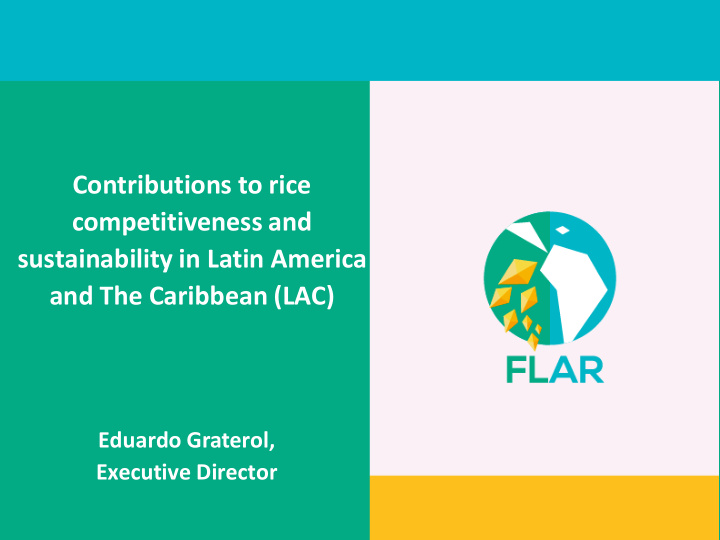



Contributions to rice competitiveness and sustainability in Latin America and The Caribbean (LAC) Eduardo Graterol, Executive Director
Diversity of rice production systems in LAC
Diversity of rice production systems in LAC Rice ecosystems: Tropical (65%) and temperate (35%) Rice cultivation: Irrigated (60%), favored rainfed (20%), and upland (acid soils) (20%) Systems: Mechanized (>80%), transplanted (15%), others (<5%)
Latin American Fund for Irrigated Rice (FLAR) Public-private alliance investing in a common platform for rice development, established since 1995. Complementarities and synergies among Latin American rice sectors: >30 organizations (farmers, milling industry, seeds companies, research centers, and others).
Members invest in FLAR to have access to improved germplasm, agronomy, and other scientific and technological outputs
FLAR’s portfolio Breeding : conventional varieties and hybrids. Agronomy : Narrowing yield gap through improved agronomical practices. Water harvesting : transforming rainfed to irrigated agricultural systems in the tropics.
Germplasm Evaluation Network 103 Experimental sites More than 80 laboratories and 150 researchers and assistants working on rice breeding
Rice breeding at FLAR FLAR delivers improved germplasm to its partners. Partners evaluate and release seeds of improved varieties. 59 FL varieties released in 14 LAC Countries.
FLAR Agronomy Program: Narrowing the yield gap using improved agronomical practices Adapted sowing date Low density sowing Good quality treated seeds Time wise and balanced nutrition Early weed control Early irrigation (irrigated systems) Contour lines leveling, crop rotation, direct seeding, minimum tillage, among others. Technology transfer approach: farmers to farmers
Crop management to adapt soybean in rotation with rice in the tropics
Water harvest concept: transforming rainfed agricultural systems into irrigated systems There is more than enough water in many of the rainfed rice areas. “Harvesting” some of this water would allow shifting from rainfed to a irrigated Uruguay agriculture. In the South Cone catchments irrigate > 900,000 hectares of rice every year. Introducing irrigation by water harvesting and improving crop Nicaragua management may allow increasing rice yields and diversify agricultural systems.
Water harvesting at FLAR FLAR has proved the concept with small farmers in Nicaragua and Mexico (3 - 4 folds increase in rice, corn, and bean yields) Ongoing project with CIAT and Global Communities in Honduras funded by USAID FONTAGRO: Regional Fund For Agricultural Technology, sponsored by The Inter-American Development Bank (IADB) and the Inter-American Institute for Cooperation on Agriculture ( IICA)) selected, in 2016, this FLAR’s project as winner of a contest for innovative cases for family farming adaptation to climate change
Final Remarks FLAR focus on improving rice production efficiency by delivering improved germplasm and promoting mass adoption of better agricultural practices including water management FLAR has become a model in which partners invest to ensure the proper delivery of relevant technologies for increasing food security and competitiveness of the Latin American rice sector
Why FLAR is interested in joining the Americas Sub Group of Paddy Rice Research Group? Rice farmers and decision makers in LAC are increasingly becoming more aware of the need to reduce GHG emissions Some FLAR partners are already involved in GHG emissions research (CIAT, Argentina, Brazil, Chile, Uruguay, and Colombia) Many other FLAR partners have no capacity, knowledge, or funding for GHG emissions research Joining the PRRG will allow us to link our most advanced partners in research with the less advanced within the network and with the global research group
www.flar.org
Recommend
More recommend